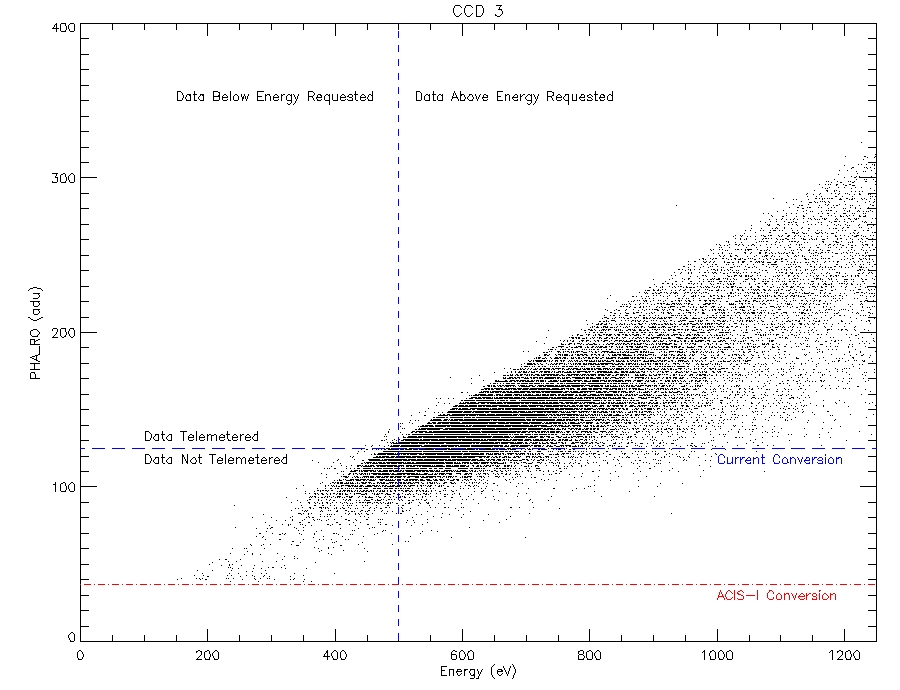
This webpage compares the changes in telemetered count rates with the new
ACIS gain conversions. As in previous work, the energy vs PHA_read
out (PHA_RO) space was divided into 4 regions.
The figure below shows these four regions for the current
conversion (blue) and the proposed ACIS-I conversion for 0.5
keV. In the current conversion, 0.5 keV corresponds to 125
ADU. In the ACIS-I conversion, 0.5 keV corresponds to 37 ADU.

The vertical line is the energy that corresponds to this ADU based on which set of conversions we are using (CCD specific, ACIS-I aimpoint or ACIS-S aimpoint). Data to the left of this line are LESS than the energy, data to the right are GREATER than the energy.
The horizontal line is the ADU used for the lowerEventAmplitude. This divides the data into those telemetered (ABOVE the line) and those not telemetered (BELOW) the line.
In this analysis, I compared the data telemetered for different conversions. I took the ranges from
| Energy:lower(in keV) | Energy:range(in keV) |
|---|---|
| As specified in the OCAT | |
| 0.1 | 15.0 |
| 0.1 | 13.0 |
| 0.2 | 13.0 |
| 0.3 | 13.0 |
| 0.5 | 13.0 |
| 0.1 | 12.0 |
| 0.2 | 12.0 |
| 0.3 | 12.0 |
| 0.5 | 12.0 |
| 0.1 | 10.0 |
| 0.2 | 10.0 |
| 0.3 | 10.0 |
| 0.5 | 10.0 |
| 1.0 | 10.0 |
To complete this analysis, I used 3 ECS observations, and 7 sky observations( HDF North, M101, Vela SNR, Cyg Loop). The table below presents the data files. The first file is the percentage change in the telemetered rate from the current conversion to the new conversions.(Current rate-new rate)/current rate. The second file is the actual count rates. "avg FI CCD" refers to all Front Illuminated CCDs that were active during this observation. The data were averaged over all active FI CCDs. "S3" refers to data on the S3 (ccd7) CCD, and "S1" refers to data on the S1 (ccd5) CCD. The link from the ObsId is the OCAT information. For the ECS observations, there is no OCAT information.
OBSID |
PERCENTAGE |
RATES |
|---|---|---|
59536 (ECS) |
||
59617 (ECS) |
||
59630 (ECS) |
||
This analysis is to help us understand how the changes will affect observations since we will be allowing more events to pass the on-board event filters. We are concerned that the use of the new conversions might make telemetry saturation more common.
Looking at the rate information files, you'll first notice that we remove a great deal of events with the current conversion when we go to higher energies (ie, the lower threshold set to 1.0keV). This is only really apparent in the HDF and M101 sky observations as the ECS observations have most of their flux above 1.0 keV.
When we look at the percentage files, you see that the percentage increase compared to the current conversion is reasonable (under 1%) for filters under 0.5keV. The largest issue is when we go to 1.0keV (33 observations out of 4574 for the mission). Here we will increase the total telemetered count rate significantly.
The Cygnus loop data show a different trend in the percentages because most of the flux is below 1.0 keV.
It is very important to note that the majority of observations with event filters specify a lower energy under 0.5keV (97.1%). In fact, 89% of the event filter observations use the default lower energy threshold and are concerned with the energy range. In the current proposal, the same conversion will be used for the Energy:range parameter. However, since the conversion for the Energy:lower parameter will change in this proposal, the sum of the Energy:lower and Energy:range parameters will be different than current.